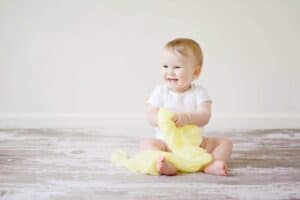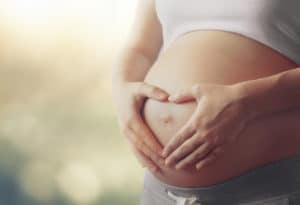The causes of jaundice in babies can be very different and range from harmless conversion processes of the body to serious diseases. In most cases, there is nothing to worry about, but in some circumstances infections or certain diseases such as hypothyroidism can be to blame for jaundice.
It is, therefore, important to monitor the baby closely in the first days of life. Plenty of daylight and breast milk can help break down bilirubin more quickly. However, if the symptoms do not improve on their own, it is better to consult a doctor. He or she can determine whether the condition is not a pathological form of neonatal jaundice.
Table of contents
What Is Jaundice?
Jaundice is also called icterus by doctors, and jaundice in babies is called neonatal jaundice. The main symptom of jaundice is yellow discolored skin. Often the eyes also turn yellowish.
But where does the yellow color come from? When the red blood cells, called erythrocytes, no longer work properly or are too old, they are broken down in the spleen. The breakdown of hemoglobin, the red blood pigment, produces bilirubin. This is a yellow bile pigment.
The bilirubin binds to the protein albumin and is transported to the liver via the blood. This bilirubin is also known as “indirect bilirubin”. In the liver, it is finally dissolved from the albumin. The resulting “direct bilirubin” flows off with the bile into the intestine.
There it is broken down into other substances and eventually excreted. If the outflow of bile is disturbed due to a disease, the bilirubin cannot be completely excreted. In adults, this is often due to gallstones or tumors. However, there are also infectious diseases such as hepatitis that can trigger jaundice.
Jaundice can also occur in babies. However, jaundice in newborns is not usually caused by a disturbed bile flow, nor is it caused by gallstones or tumors.
It is often a normal physiological process that the baby’s body goes through in the first days of life. After birth, the baby’s body has to break down large amounts of red blood cells.
This is because the baby now needs a different blood pigment than it did during pregnancy. The breakdown of all these red blood cells produces a lot of bilirubin. The baby’s liver can be a little overwhelmed with this task in the first few days, as it is often not yet fully mature.
If the bilirubin accumulates in the blood, the typical yellow coloration occurs. In most cases, however, the bile pigment is gradually broken down on its own.
What Types Of Neonatal Jaundice Are There?
Doctors distinguish between different forms of jaundice in babies. So-called physiological neonatal jaundice is the most common form and does not require therapy, as it is a completely normal process.
However, the other forms of neonatal jaundice are considered pathological and must be treated accordingly.
Physiological Neonatal Jaundice
This is the normal jaundice in the baby that occurs because the baby’s immature liver cannot cope as quickly with the high breakdown of red blood cells.
Physiological neonatal jaundice usually occurs between the third and sixth day of life. Bilirubin levels normalize on their own within ten days.
If the symptoms have still not subsided after the second week of life, it could be a pathological form of jaundice, which must then be treated without fail.
Premature Jaundice
If high bilirubin levels are already present on the first day after birth, this is a case of premature jaundice. This may be caused by blood group incompatibility between baby and mother or congenital anemia. In that case, jaundice in the baby must be treated in any case.
Prolonged jaundice
If bilirubin levels are still elevated after two weeks, this requires closer examination. It may be due to diseases such as hypothyroidism or infectious diseases.
Breast milk can also cause prolonged jaundice in the baby. However, this is not dangerous. If there are slightly elevated bilirubin levels in a fully breastfed baby, it is usually harmless and rarely requires therapy.
Severe Jaundice:
In the severe form of neonatal jaundice, permanent neurologic damage may occur. When the concentration of bilirubin is severely elevated, it eventually accumulates in the central nervous system and can cause major damage there.
This is also known as kernicterus. Severe jaundice is when bilirubin levels rise above 18 milligrams per deciliter. It must then be treated in any case.
Note: In any case, it is important to find out the cause of jaundice in the baby, especially if it lasts for a long time or occurs on the first day of life. In most cases it is harmless, but serious diseases can be behind it.
How Can You Recognize Newborn Jaundice?
Wondering how to tell if your baby has jaundice? The main symptoms of jaundice are yellowish discolored skin and eyes, hence the name. However, depending on the severity, there may be additional symptoms:
- Sluggishness.
- Fatigue.
- Weakened reflexes.
- Brownish urine.
- Pale (or yellow) stools.
- Muscle weakness.
- Decreased need to drink.
Your baby will probably be screened for neonatal jaundice by a doctor during the 1st week of life. If symptoms of jaundice are present in the baby, such as yellow skin and conjunctiva, the doctor will use special blood tests to check bilirubin levels.
If the levels are severely elevated, the cause must be sought. If there are additional symptoms such as apathy, weak reflexes, yellow bowel movements, and a weakened desire to drink, it is usually a more severe form of neonatal jaundice that must be treated in any case.
Your doctor will advise you on treatment options. As a rule, phototherapy is performed. This usually makes the baby’s jaundice disappear quickly.
Risk Factors For Neonatal Jaundice
Jaundice usually occurs in the baby because it can take a few days for the liver to process all the bilirubin. However, there are some factors that can promote newborn jaundice. These include premature birth. Babies who are born prematurely usually do not have a fully functioning liver.
As a result, the liver cannot process bilirubin quickly enough. In addition, the bile pigment can reach the brain more easily and cause damage. Phototherapy is therefore recommended earlier for premature babies than for healthy newborns.
There are also certain medications and diseases that can cause the liver to be unable to do its job properly. These conditions include, for example, hypothyroidism and congenital disorders of bile excretion.
Blood group incompatibilities between mother and child also increase the risk of jaundice in the baby. Blood group incompatibility often results in the breakdown of many red blood cells. This produces a lot of bilirubin.
The liver of the newborn is usually overwhelmed by this and jaundice develops. Birth hematomas, bruises that occur during birth, also increase the risk of neonatal jaundice.
Newborn Jaundice – How To Get Rid Of It?
As a rule, jaundice in babies does not require therapy and usually disappears all by itself. At least this is true if it is physiological neonatal jaundice.
However, if the bilirubin levels in the blood exceed a critical value, the jaundice must be treated to prevent permanent damage. What are the therapeutic options?
Phototherapy With Blue Light
Phototherapy is very commonly performed and is considered one of the most effective measures for neonatal jaundice. For this purpose, the baby is treated with a special light for 1-2 days in an incubator.
It lies, dressed only in a diaper and an eye mask, under a special lamp that irradiates the skin with blue light. Alternatively, so-called light mats can be used, which emit the blue light via special fibers. In this case, the newborn only has to be placed on the mat.
The luminous mat and the phototherapy lamp can also be used in combination. The principle of operation of both methods is the same. The emitted light waves break down the bilirubin in the baby’s skin and convert it into a water-soluble form that can eventually be excreted through urine and sweat.
It is important that the baby receives adequate fluids, as he or she loses a lot of water through sweating during phototherapy.
Blood Exchange
Blood exchange is only necessary in very severe cases of jaundice. This may be the case, for example, if there is rhesus incompatibility. This is a blood group incompatibility between mother and baby that causes an immune reaction.
This can be extremely dangerous for the baby. However, this happens very rarely. A blood test is performed on every pregnant woman to determine blood group and rhesus factor. With the help of appropriate preventive measures, complications can usually be avoided.
What You Can Do Yourself
Even if the bilirubin levels are below the critical value and no treatment is necessary, there are some things you can do as a mother to help your baby’s jaundice disappear quickly. For example, make sure your baby gets enough daylight.
Natural light can support the breakdown of bilirubin. However, you should never expose your baby to the strong midday sun, as his skin is very sensitive. Instead, take him for a walk in the early morning or late afternoon.
In addition, you should breastfeed your baby frequently and regularly. Breastfeeding promotes intestinal transit and thus the elimination of bilirubin.
If your child develops neonatal jaundice in the first few days of life, you should not worry at first. It often disappears by itself. However, if you have a bad feeling or the symptoms do not get better, contact a doctor to be on the safe side. He or she will be able to tell you whether there might be another cause.
Sources
https://www.baby-und-familie.de/Neugeborenengelbsucht
https://www.mami-ratgeber.de/babygesundheit/krankheiten/typische/neugeborenengelbsucht/











1 thought on “Jaundice In Babies: How To Recognize The Disease”